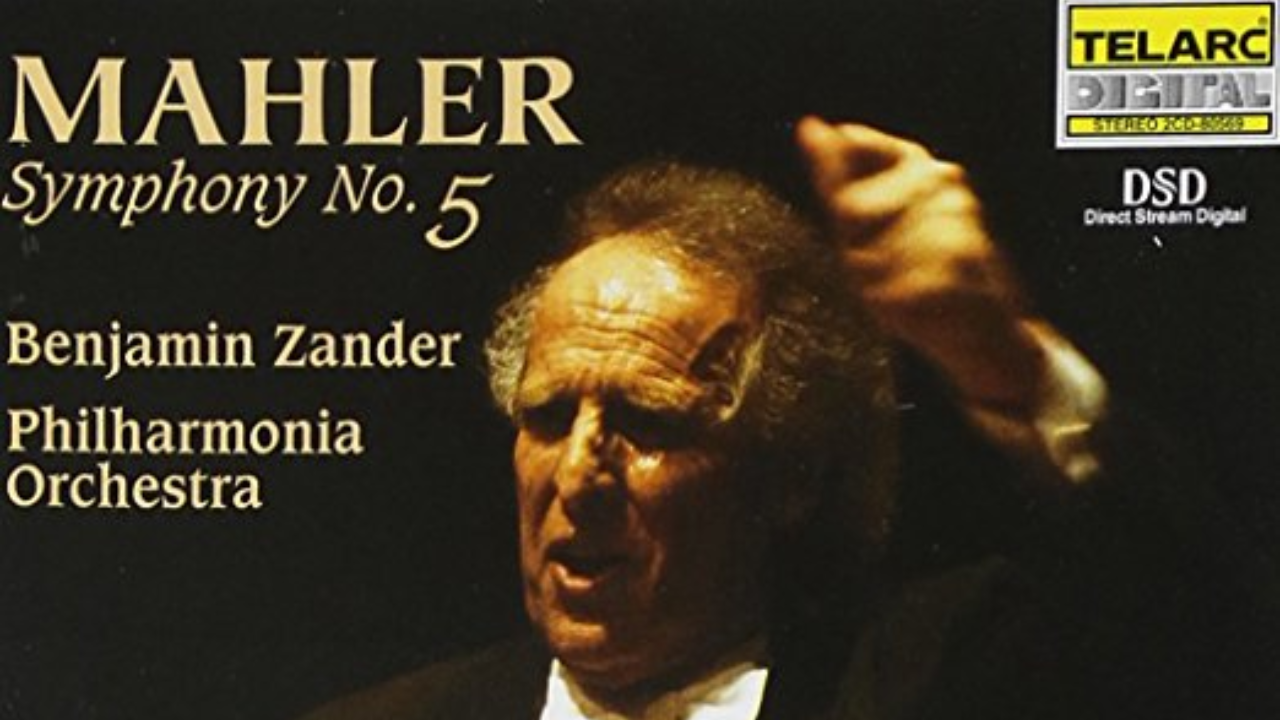Mahler - Symphony no. 5

My hear sank when I received this disc, though I had been anticipating its release, and was hoping for the assignment. There have been so many good recordings of the Mahler Fifth recently: Chailly’s monumental one, Gatti’s heartfelt, emotion-charged one, and Barenboim’s gritty, no-nonsense one (well, I liked it). What if I found this one to be average? Would I – gasp – have to compromise my Principles out of respect for Ben Zander? Not to worry. This is a revelatory Fifth on several levels.
The word “balance” appeared in my notes before I listened to the bonus lecture disc (in which it appears several times), which is full of the usual Zanderian wit, insight, anecdote, singing, demonic laughter, and marvelous music (one especially notable example is a concert recording if ” Ich bin der Welt abhandeb gekommen”, sung by the incomparable Jane Struss, whom I had the privilege to hear in this music last fall). Zander not only balances a “monumental” approach and an analytical one, but manages to render the often-dense orchestration transparent without undue highlighting or exaggeration. As he notes in his lecture, this is a piece in which there is no accompaniment – every instrument is essential to the musical fabric.
Make no mistake, though: this performance isn’t lightweight. The first part of the symphony takes full advantage of the orchestration, with the Philharmonia in full splendor. but details emerge quickly: How perfectly funereal is the side drum, audible for once, a dry implacable companion throughout the first movement. This movement is one of sorrow, certainly, but also one of failed joy and aspiration: the “collapse” is cataclysmic. There is also an edgy quality in the strings during the third section – the section that Dr Constantine Floros calls the second trio. And how often do we hear a muted trumpet in F in the coda? Much of the time it is played piano, but the score is clearly marked mit dampfer.
The lurching quality of the second movement is well captured in the somewhat measured opening tempo: This movement tends to fly apart if the opening is too fast (Gatti), but it loses any sense of turbulence (it is marked Sturmisch) when taken too slowly (Barbirolli). Yoel Levi’s underrated Fifth, also on Telarc, manages to find just the right balance between music and deliberate, as Zander does here. Of the utmost importance is to convey a sense of frustrated momentum, as the movement repeatedly changes gear. Zander capitalizes on the kaleidoscope orchestration, allowing the carping winds and strings to sound, then encouraging the long, Romantic line from the same instruments moments later. The beautiful, lamenting “cello” theme (beginning at 4:08) that plays over ominous timpani is a highlight of this performance. Another is the glorious chorale that ends the recapitulation – we are transported back to the (lost) paradise of the Fourth Symphony.
Mahler’s early description of the Scherzo as “the world without gravity” is surely applicable here. Just as the previous moment is all frustrated energy, this one is constantly taking flight, and this performance does too. Judicious use of rubato serves to give extra lilt to the lovely Viennese themes that spring up and the darker moments – the horn call beginning at 5:00, which Henri-Louis de La Grange suggests is reminiscent of the Third Symphony – don’t manage to stifle the sense of joy. This leads to one of Zander’s real trumps: his second trio, with its pizzicato strings, sounds like a string quartet (he names it thus in his lecture), with the violins divided and the counterpoint quite audible- this kind of intimate detail isn’t available if the strings are in their conventional seating.
It’s hard to explain exactly what transports a performance of the Adagietto into that ethereal realm of the truly transpired. Tempo is surely part of it: as Gilbert Kaplan and Henri Louis de La Grange have documented, Mahler and his earliest interpreters played this exquisite miniature at a tempo producing a timing from about seven minutes (Mengelberg) to about nine minutes (Mahler, Hamburg, 1905). Zander’s is 8:33, squarely within that range. But it’s more than that. In the present recording, the reason that this performance transcends the mundane is the harp: it sounds as if it is playing ad lib (Mahler alternates the markings “flowing” and “slow-down”), so that the strings soar freely, breathing the long line as if without bar lines; too often the harp is used for punctuation, producing an audible regularity that interrupts the flow (I was gratified to hear Zander validating this analysis in lecture, though the effect is clear from his performance). The divided violins again add a more complete tonal picture.
Most infectious in this performance of the Rondo Finale is not the rambunctious energy but the conveying sense of joy with which Mahler plays with his materials. Once again there is balance: Glorious brass fanfares give way to sweet strings and winds. The lamenting themes that alternate with the declamatory ones in the Rondo are no longer bitter, but instead provide a wistful echo of the yearning expressed in the Adagietto. That sense of balance is maintained right up to the coda, at which point the music simply lifts off. As Zander points out, Mahler brings the listener full circle with the chorale from the first movement, gloriously triumphant. Telarc’s sound is naturally spectacular, with the stress on “naturally.” Chailly received truly spectacular sound from Decca, but how much more thrilling it is to hear the orchestra without an extra bass boost and resonance.
While the issue of the metronome marks is essential to Zander’s Beethoven series, crucial to his Mahler is the timing of the performances. With Bernstein (DG) clocking in at almost 75 minutes, it’s instructive to note that Zander’s performance lasts just under 68. Mahler was timed at 68 minutes in 1905. Authentic Mahler, anyone?
Click here to listen to Mahler’s Symphony no. 5.
 Christopher Abbot - Fanfare Magazine
Christopher Abbot - Fanfare Magazine